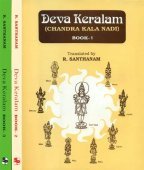Kalakuta, Kāḷakūṭa, Kālakūṭa, Kālakūta, Kala-kuta, Kālakuṭa: 22 definitions
Introduction:
Kalakuta means something in Buddhism, Pali, Hinduism, Sanskrit, Marathi, biology. If you want to know the exact meaning, history, etymology or English translation of this term then check out the descriptions on this page. Add your comment or reference to a book if you want to contribute to this summary article.
Kalakuta has 21 English definitions available.
The Sanskrit term Kāḷakūṭa can be transliterated into English as Kalakuta or Kaliakuta, using the IAST transliteration scheme (?).
Languages of India and abroad
Sanskrit dictionary
[Deutsch Wörterbuch]
Source: Cologne Digital Sanskrit Dictionaries: Böhtlingk and Roth Grosses Petersburger WörterbuchKalakūṭa (कलकूट):—(kala + kūṭa) m. Nomen proprium eines Kriegerstammes und des von ihm bewohnten Gebietes [Pāṇini’s acht Bücher 4, 1, 173.] — Vgl. kālakūṭa .
--- OR ---
Kālakūṭa (कालकूट):—
1) m. n. ein best. in einer Knolle enthaltenes Gift [Suśruta 2, 252, 6. 21.] [Amarakoṣa 1, 2, 1, 10.] [Hemacandra’s Abhidhānacintāmaṇi 1196.] [Mahābhārata 3, 540.] [Pañcatantra 105, 2.] ein bei der Quirlung des Oceans hervorgekommenes Gift [Mahābhārata 1, 1152.] kālimā kālakūṭasya nāpaiti harasaṃgamāt [Hitopadeśa III, 16.] [ŚUK. 44, 10.] [Caurapañcāśikā 50.] [Bhāgavatapurāṇa 8, 6, 25. 7, 37.] Gift überh. (m. nach [Rājanirghaṇṭa im Śabdakalpadruma]): stana [Bhāgavatapurāṇa 3, 2, 23.] —
2) m. Myrrhe (vola) [Rājanirghaṇṭa im Śabdakalpadruma] —
3) m. Nomen proprium eines Gebietes am Himālaya und des daselbst wohnenden Volkes [Mahābhārata 1, 4637. 2, 793. 5, 599.] plur. [2, 997.] Vgl. [ Kunde des Morgenlandes II, 22.] [Lassen’s Indische Alterthumskunde I, 694, Nalopākhyāna 2.] —
4) m. ein Beiname Yama's [Hemacandra’s Abhidhānacintāmaṇi 35]; vgl. kālakuṇṭha . — Das Wort zerlegt sich in kāla + kūṭa, aber der geographische Name wird doch wohl mit kalakūṭa (oder ist dafür etwa auch kālakūṭa zu lesen?) in Zusammenhang stehen.
--- OR ---
Kālakūṭa (कालकूट):—
1) bei der Quirlung des Oceans [Spr. 1636.] [Oxforder Handschriften 42,b,33.]
Source: Cologne Digital Sanskrit Dictionaries: Sanskrit-Wörterbuch in kürzerer FassungKalakūṭa (कलकूट):—m. Pl. Nomen proprium eines Kriegerstammes.
--- OR ---
Kālakūṭa (कालकूट):——
1) m. (*n.) — a) ein best. in einer Knolle enthaltenes Gift. — b) ein bei der Quirlung des Oceans zu Tage gefördertes Gift. — c) Gift überh. —
2) m. — a) Nomen proprium — α) Pl. eines Volkes. — β) eines Landes. — b) *Beiname Yama's.
Sanskrit, also spelled संस्कृतम् (saṃskṛtam), is an ancient language of India commonly seen as the grandmother of the Indo-European language family (even English!). Closely allied with Prakrit and Pali, Sanskrit is more exhaustive in both grammar and terms and has the most extensive collection of literature in the world, greatly surpassing its sister-languages Greek and Latin.
See also (Relevant definitions)
Starts with: Kalakutagriva, Kalakutaka, Kalakutam, Kalakutankata, Kalakutapati, Kalakutatantra, Kalakutavisha.
Full-text (+23): Kalakuti, Kalakutiya, Kalakutaka, Kalakutam, Kalankuta, Kalakutapati, Mahapancavisha, Kalakutankata, Kalkut, Kalakutatantra, Tamrakuta, Kalakutavisha, Parivritta, Candapati, Candeshvara, Candipati, Candesha, Durjara, Kalika, Vatsanabha.
Relevant text
Search found 41 books and stories containing Kalakuta, Kāḷakūṭa, Kālakūṭa, Kālakūta, Kaḷakūṭa, Kalakūṭa, Kala-kuta, Kāla-kūṭa, Kala-kūṭa, Kālakuṭa; (plurals include: Kalakutas, Kāḷakūṭas, Kālakūṭas, Kālakūtas, Kaḷakūṭas, Kalakūṭas, kutas, kūṭas, Kālakuṭas). You can also click to the full overview containing English textual excerpts. Below are direct links for the most relevant articles:
Amarakoshodghatana of Kshirasvamin (study) (by A. Yamuna Devi)
Miscellaneous (2): Varieties of poison (Viṣabheda) < [Chapter 3 - Social Aspects]
Rudra-Shiva concept (Study) (by Maumita Bhattacharjee)
2.11. Rudra as Nīlagrīva or Nīlakaṇṭha < [Chapter 6a - The Epithets of Rudra-Śiva]
Rasa Jala Nidhi, vol 3: Metals, Gems and other substances (by Bhudeb Mookerjee)
Part 9 - Tuber Poison (9): Kala-kuta < [Chapter XXX - Visha (poisons)]
Part 18 - Tuber Poison (18): Keshara, Pradipana or Mahabisha (Mahavisha) < [Chapter XXX - Visha (poisons)]
Jivanandana of Anandaraya Makhin (Study) (by G. D. Jayalakshmi)
Analysis of Lord Parameśvara < [Chapter 6 - Dramatic aspects of the Jīvanandana Nāṭaka]
Analysis of Adbhuta-rasa < [Chapter 6 - Dramatic aspects of the Jīvanandana Nāṭaka]
The Skanda Purana (by G. V. Tagare)
Chapter 14 - Kuṭuṃbeśvara (kuṭuṃba-īśvara-liṅga) < [Section 2 - Caturaśīti-liṅga-māhātmya]
Chapter 9 - The Churning of the Ocean < [Section 1 - Kedāra-khaṇḍa]
Chapter 11 - Churning for the Nectar: Birth of the Poison Kālakūṭa < [Section 9 - Vāsudeva-māhātmya]
Sahitya-kaumudi by Baladeva Vidyabhushana (by Gaurapada Dāsa)
Text 10.228 < [Chapter 10 - Ornaments of Meaning]
Text 10.240 < [Chapter 10 - Ornaments of Meaning]
Text 10.242 < [Chapter 10 - Ornaments of Meaning]
Related products
